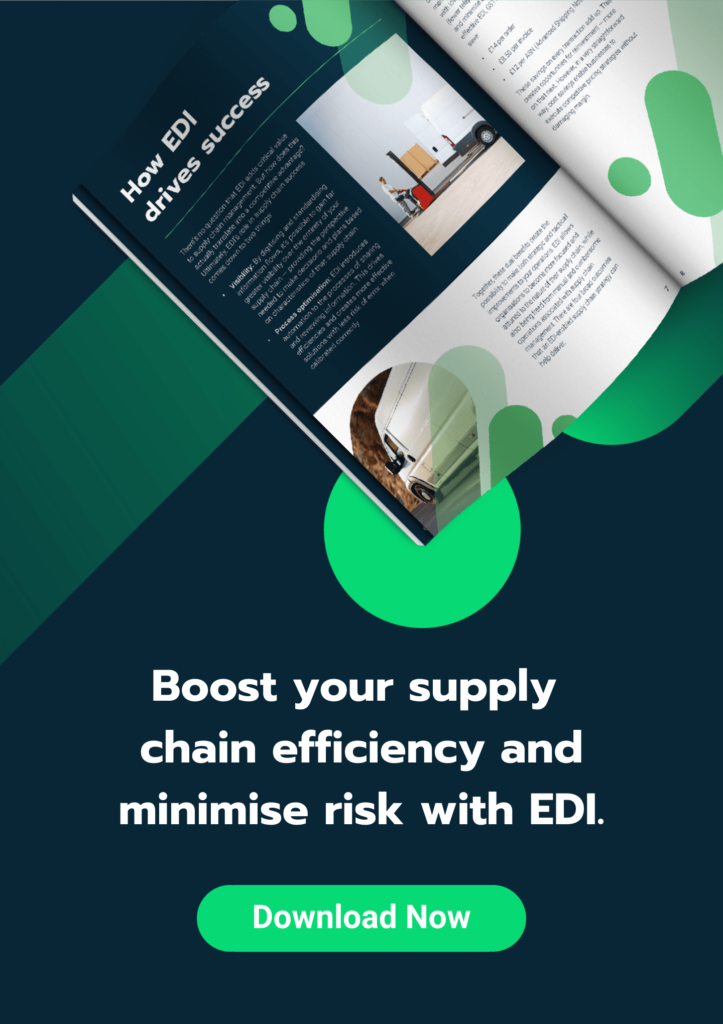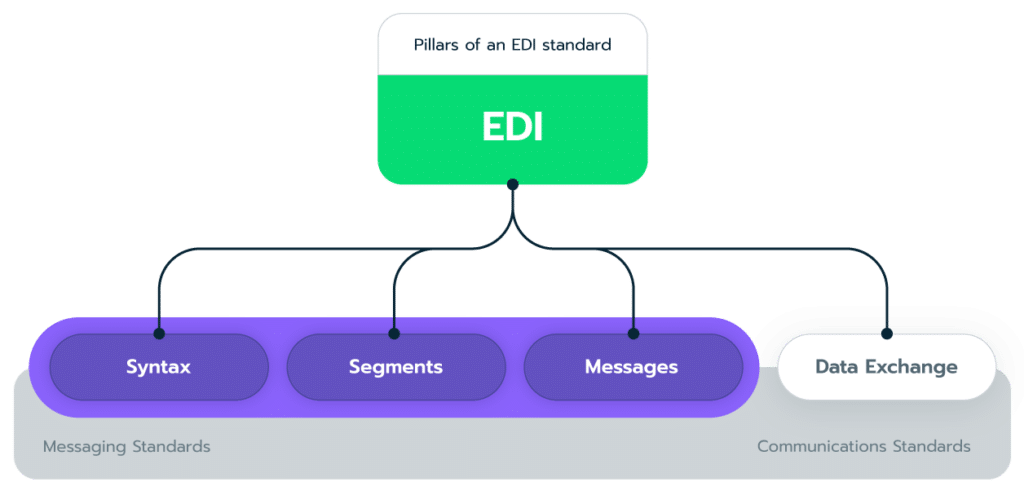A Crash Course on EDI Industry Standards: ANSI x12 vs EDIFACT vs OFTP and more
Supply chains are complex. Globalisation has only compounded this reality. Although post-pandemic prediction of “slowbalisation” may reduce the steady 3.4% per annum growth in globalisation that we’ve seen since the 70s, the remote working transition could easily see this shift the other way.
EDI (Electronic Data Interchange) is a critical part of simplifying complex and global supply chain communication. However, to do that, it’s critical to understand the different EDI standards out there — and build an EDI solution that can flexibly accommodate a wide range of standards.
Modern approaches to EDI have simplified the adoption of this critical supply chain management capability — as the implementation of EDI needs to be seamless. This, in addition to the need to accommodate globalisation, are central reasons experts now predict the market is set to double in the next six years.
Here, we’re going to take a deep dive into those EDI industry standards by considering the most commonly used solutions, and how businesses can adapt to accommodate each of them.


Further reading: For further information on how to devise a supply chain strategy fit for 2021, check out our blog — How to Improve your Supply Chain Strategy Ready for 2021
EDI Messaging Standards vs Communication Standards
Before we get into the specifics, we need to set out some definitions. When we talk about EDI standards and protocols, we refer not only to a variety of different standards but also to two distinct subsets, both of which ultimately need to work alongside each other for overall supply chain success. Those subsets are:
- Communication standards (or protocols) which provide methods of data transference. This is the technical framework by which a message is communicated.
- Messaging standards which involve how information is presented within the context of those protocols. This is the formatting that is used to standardise how those messages are received.
Here, we’re going to break each down to size to find out what they stand to do for you, and how you can find your standard footing in even this global supply chain landscape. Although some standards are better suited for different tasks, what fundamentally defines an effective EDI system is its ability to accommodate a range of standards. Flexibility is the key to efficient supply chain management.

Communication Standards (Protocols)
Communication standards, or protocols, are key cogs in the EDI machine. They facilitate the exchange of information between data sources. Protocols can be either EDI-specific, repurposed or accountable for variations across supply chains. Businesses often need to accommodate more than one option. But, before that’s possible, you need to get to grips with the standards you’ll most likely come across, and what exactly each one has to offer.
- OFTP (Odette file transfer protocol)
OFTP is an EDI-specific protocol that was developed by ODETTE International, a European governing body for the automotive industry back in the 1980s. Our very own co-founder, Phillip Friend, helped to develop this all-important go-to protocol for big names like BMW, Ford, and Peugeot. A 2017 update that accommodates cloud-based communications, transmission restarts, and large file compressions, has delivered significant modernisation to OFTP. This contributed to its continued success across a number of industries including manufacturing, retail and finance.
Pros:
- File compression
- Built-in data integrity and delivery receipts
- Second-level addressing (network and mailbox ID)
- Interoperability
Cons:
- Complex standalone integrations
- Requires registration with ODETTE organisation
- Can be expensive if implemented in-house
- AS2 (Applicability Statement 2)
The now obsolete, AS1, was developed back in the 90s and was the first ASX protocol to establish the signing, encryption, and MDN (message disposition notification) conventions. In 2002, these conventions became fundamental to upgraded, internet-based AS2. AS2 has become a prominent EDI protocol in the retail and consumer goods adopted by both Walmart and Amazon. Notably, its point-to-point connections which, essentially, create data transfer ‘envelopes,’ supported by AS2 certificates (and, interestingly, HTTP protocol) for increased data security at all times.
Pros:
- Limitless data exchange
- The ability to exchange all file formats
- Transfer point-to-point or indirectly via VAN
- No yearly or transaction fees
Cons:
- Single level addressing (network only)
- Separate application integration
- High maintenance efforts
OFTP1 & 2 are very similar to AS2 in reality — they both offer very strong encryption and reliability. However, OFTP 2 does in fact come out on top, technically, as it supports second-level addressing too (network and mailbox ID). Whereas AS2 relies on singular addressing, they use network only.
Beyond this the main differences between the two are geography and industry. Broadly speaking OFTP is more prevalent in Europe, and AS2 is more utilised in the US. With regard to industry, the former is commonly used in the automotive sector, and the latter in the retail sector.
- PEPPOL (Pan-European Public Procurement Online)
Cloud-based PEPPOL is both a communications and a messaging standard that was developed by the European Commission and a consortium of 17 partners back in 2008. Initially, its development stemmed from the goal to enable electronic B2B communications across government boards. Since its procurement by non-profit organisation OpenPEPPOL, back in 2012, it’s grown steadily in popularity — specifically across healthcare supply chains since its adoption within the NHS. PEPPOL focuses on providing interoperability and trading between connected parties using a 4-corner model that requires an access point (an AP), a PEPPOL network ID, a receiver, and a sender.
Pros:
- Standardised network connections
- Compatibility with existing e-invoice platforms
- Capabilities including electronic ordering/delivery notes
Cons:
- A relatively untested new protocol
- PEPPOL network ID required
- Risk of inefficient connection to the network
- FTP, SFTP, and HTTP
While not specifically developed to accommodate EDI, the protocols FTP, SFTP, and HTTP are commonly repurposed and used within an EDI context. This makes the common features within a supply chain environment — and they are all standards you need to consider within your EDI system.
- FTP (file transfer protocol): The first reliable file transfer protocol developed back in 1971. FTP is largely used for inner company file transfers — though added security for supply chain processes is possible when used within a VPN.
- SFTP (Secure File Transfer Protocol): Originally developed by the Internet Engineering Task Force, in the late 90s, SFTP protocols run over the SSH protocol to encrypt data while it’s in transit, and decrypt it once it arrives at its destination. This ensures data security but, unfortunately, fails to offer any real data management.
- HTTP (Hypertext Transfer Protocol): Established in 1991 as the underlying protocol of the World Wide Web, HTTP file transfers enable computer-to-computer connections requiring nothing more than the worldwide web. Security does leave a lot to be desired but, where ease is concerned, it’s certainly difficult to imagine anything better.
EDI messaging standards
While protocols concern how data is exchanged, messaging standards are all about the data itself. In most instances, messaging standards follow four key principles which are —
- Syntax
- Codes
- Message designs
- Identification values
Given that there isn’t a standard format where messaging is concerned either, many businesses turn to a process called data mapping to translate each file into a data format that their systems can understand. The standard variations on the table include:
- UN/EDIFACT (the United Nations rules for Electronic Data Interchange for Administration, Commerce and Transport)
The most popular EDI file format outside of North America, and the only truly international set of standards, UN/EDIFACT was first developed for use by the United Nations in the 1980s. Now widely used, especially in Europe, EDIFACT facilitates multi-country and multi-industry exchanges. This has led to several industry-specific subsets, such as retail-based EANCOM. EDIFACT operates within a hierarchical structure. The pillars of which work together to create elements that are then normalised across EDIFACT structures to facilitate these famously easy, and incredibly popular, data interchanges.
- ASNI x 12 (ASC X12)
Initially developed by the ANSI subsidiary Accredited Standards Committee (ASC) in 1977, ASNI x12, commonly shortened to just X12, is a preferred standard for 300,000 businesses worldwide. Most commonly used in North America, X12 defines uniform segments and elements to describe file format information which is then used for a wide range of capabilities including invoices, purchase orders, and delivery notes. Unlike EDIFACT, which uses six-digit codes, X12 uses three-digit numbers for over 300 standards —each of which falls under a different industry-specific subset, including:
- AIAG – Automotive Industry Action Group
- EIDX – Electronics Industry Data Exchange Group (CompTIA)
- HIPAA – Health Insurance Portability and Accountability Act
- And more
- PEPPOL
As touched on above, PEPPOL has been making waves as both a communications protocol and a messaging standard since its conception for use by government officials back in 2008. Embedded in eProcurement and eBusiness exchange systems, PEPPOL Business Interoperability Specifications ‘BIS’, are formal requirements to ensure pan-European data interoperability and have been widely used within the public sector, specifically within the NHS, since 2012.
- VDA (Verband der Automobilindustrie)
Slightly more niche than other standards mentioned, VDA is a go-to within the German automobile industry, with the most recent iteration from 2017, VDA 6.3, providing a global EDIFACT message that aims to simplify previously convoluted global automotive trades. With a focus on support, future-proofing, and globalisation, VDA standards are now mandatory for tier 1 and tier 2 sellers in attempts to evaluate and improve controls across the board.
- UN/GTDI TRADACOMS (Trading Data Communications Standard)
An early EDI messaging standard used primarily in the UK retail sector, TRADACOMS was introduced in 1989 and was one of the precursors of EDIFACT. The standard was maintained and extended by the UK Article Numbering Association — now called GS1 UK. Technically, this standard has been obsolete since development ceased in 1995 in favour of GS1 EDI EANCOM. However, the lasting functionality of the solution has seen its retention by a large part of the UK retail sector.
An effective EDI system needs standard flexibility
Standards and protocols are the bread and butter of EDI and always will be but, as you can see, each option brings both strengths and weaknesses to the table. Most problematic of all, however, are the incompatible standards that have long left computer systems entirely unable to understand each other, and thus complicated rather than simplified supply chain processes.
This is something that trading partners need to overcome, and quickly if they’re to see any success on the global floor. Remember, you not only need to take into account your own EDI standards (and in-house expertise to manage your EDI system) but also the standards and expertise of every partner within your supply chain. Luckily, that goal is now easier than ever to achieve with EDI mapping that enables the facilitation of all standards and protocols, no matter the language barriers along the way.
Here at Data Interchange, we understand the importance of this benefit well, which is why mapping capabilities are central to our modern EDI overhaul — EDI-as-a-service. EDI-as-a-Service harnesses both managed services and cloud-based tools to simplify the creation of a flexible EDI solution that overcomes the challenges of a legacy EDI approach. With these benefits on board, you can ensure that you’re talking the same language as even your overseas business partners, no matter their existing EDI experience, bringing the ease, and communications of EDI, even within modern business settings.


Further reading: If you want to learn more about how EDI-as-a-Service can transform commercial outcomes, check out our eBook — The Supply Chain Centered Business.



























































































































